Search Result
Results for "
AMD
" in MedChemExpress (MCE) Product Catalog:
1
Isotope-Labeled Compounds
| Cat. No. |
Product Name |
Target |
Research Areas |
Chemical Structure |
-
- HY-15971
-
|
GENZ-644494 hexahydrobromide
|
CXCR
HIV
|
Infection
Endocrinology
|
|
AMD 3465 hexahydrobromide (GENZ-644494 hexahydrobromide) is a potent antagonist of CXCR4, inhibits binding of 12G5 mAb and CXCL12 AF647 to CXCR4, with IC50s of 0.75 nM and 18 nM in SupT1 cells; AMD 3465 also potently inhibits the replication of X4 HIV strains (IC50: 1-10 nM), but has no effect on CCR5-using (R5) viruses.
|
-

-
- HY-50101A
-
|
AMD-070 trihydrochloride
|
CXCR
HIV
|
Infection
Endocrinology
Cancer
|
|
Mavorixafor trihydrochloride (AMD-070 trihydrochloride) is a potent, selective and orally available CXCR4 antagonist, with an IC50 value of 13 nM against CXCR4 125I-SDF binding, and also inhibits the replication of T-tropic HIV-1 (NL4.3 strain) in MT-4 cells and PBMCs with an IC50 of 1 and 9 nM, respectively.
|
-

-
- HY-15971A
-
|
GENZ-644494
|
CXCR
HIV
|
Infection
Endocrinology
|
|
AMD 3465 (GENZ-644494) is a potent antagonist of CXCR4, inhibits binding of 12G5 mAb and CXCL12 AF647 to CXCR4, with IC50s of 0.75 nM and 18 nM in SupT1 cells; AMD 3465 also potently inhibits the replication of X4 HIV strains (IC50: 1-10 nM), but has no effect on CCR5-using (R5) viruses.
|
-
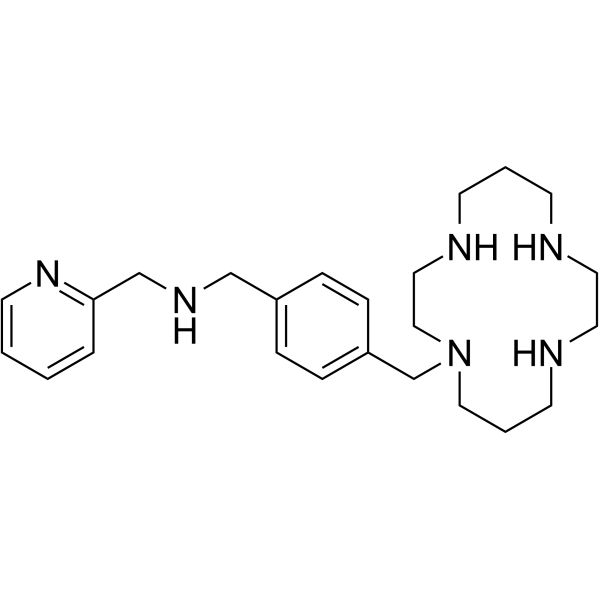
-
- HY-50101
-
|
AMD-070
|
CXCR
HIV
|
Infection
Endocrinology
Cancer
|
|
Mavorixafor (AMD-070) is a potent, selective and orally available CXCR4 antagonist, with an IC50 value of 13 nM against CXCR4 125I-SDF binding, and also inhibits the replication of T-tropic HIV-1 (NL4.3 strain) in MT-4 cells and PBMCs with an IC50 of 1 and 9 nM, respectively.
|
-
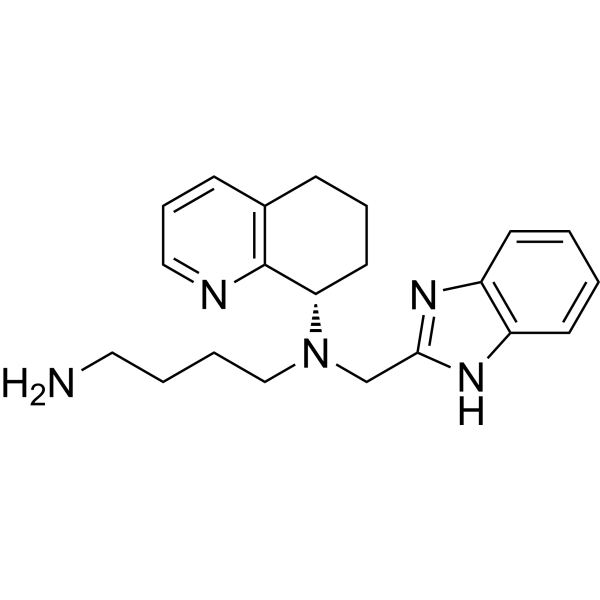
-
- HY-RS00644
-
|
|
Small Interfering RNA (siRNA)
|
Others
|
|
AMD1 Human Pre-designed siRNA Set A contains three designed siRNAs for AMD1 gene (Human), as well as a negative control, a positive control, and a FAM-labeled negative control.
|
-
AMD1 Human Pre-designed siRNA Set A
AMD1 Human Pre-designed siRNA Set A
-
- HY-10046
-
Plerixafor
Maximum Cited Publications
60 Publications Verification
AMD 3100; JM3100; SID791
|
CXCR
HIV
|
Infection
Inflammation/Immunology
Endocrinology
Cancer
|
|
Plerixafor (AMD 3100) is a selective CXCR4 antagonist with an IC50 of 44 nM. Plerixafor, an immunostimulant and a hematopoietic stem cell (HSC) mobilizer, is an allosteric agonist of CXCR7. Plerixafor inhibits HIV-1 and HIV-2 replication with an EC50 of 1-10 nM .
|
-
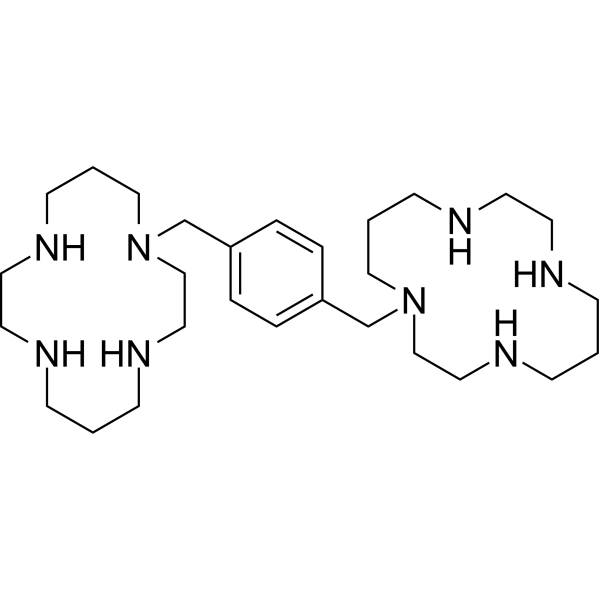
-
- HY-131468
-
|
AMD473; ZD0473
|
Others
|
Cancer
|
|
Picoplatin (AMD473) is a platinum-based antineoplastic agent. Picoplatin is specifically to circumvent thiol-mediated drug resistance by sterically hindering its reaction with glutathione (GSH) while still retaining the ability to form cytotoxic lesions with DNA .
|
-
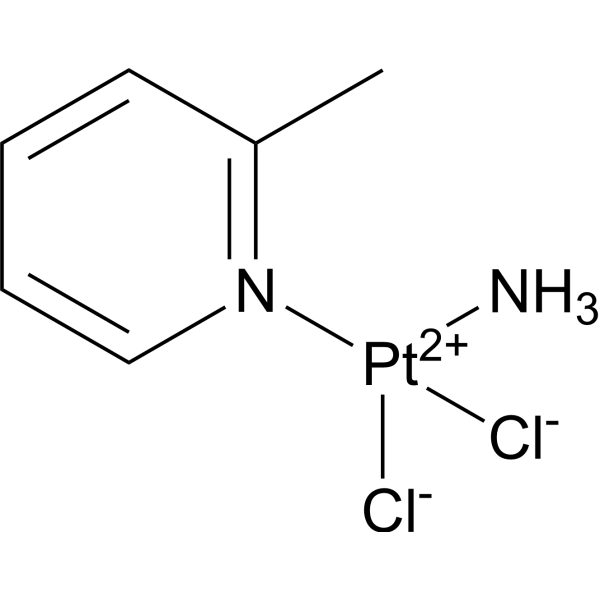
-
- HY-50912
-
-
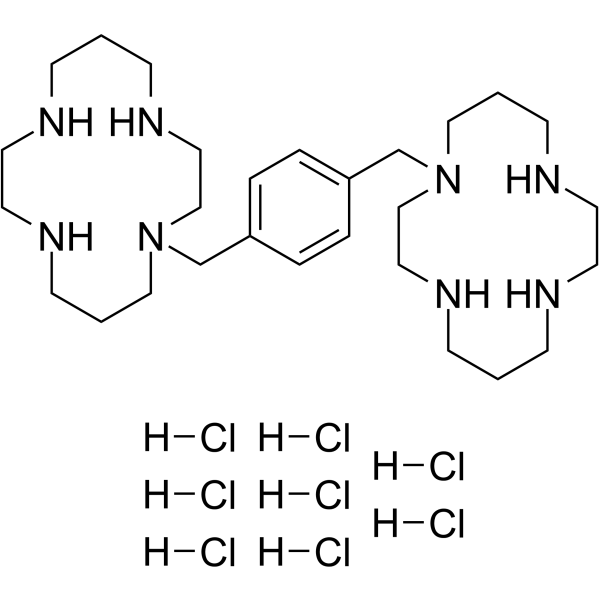
-
- HY-P99576
-
|
OG1953
|
VEGFR
|
Others
|
|
Tarcocimab (OG1953) is a humanized anti-VEGFA monoclonal antibody (IgG1 type). Tarcocimab is available for research in retinal vein occlusion (RVO) and wet age-related macular degeneration (AMD).
|
-

-
- HY-108801
-
|
VEGF Trap; VEGF-TRAPR1R2; VEGF-trapR1
|
VEGFR
|
Cardiovascular Disease
Metabolic Disease
|
|
Aflibercept (VEGF Trap) is a soluble decoy VEGFR constructed by fusing the Ig domains of VEGFR1 and VEGFR2 with the Fc region of human IgG1. Aflibercept inhibits VEGF signaling by reducing VEGF-regulated processes. Aflibercept can be used for thr research of age-related macular degeneration (AMD) and cardiovascular disease .
|
-

-
- HY-108801A
-
|
|
VEGFR
|
Cardiovascular Disease
Metabolic Disease
|
|
Aflibercept (VEGF Trap) is a soluble decoy VEGFR constructed by fusing the Ig domains of VEGFR1 and VEGFR2 with the Fc region of human IgG1. Aflibercept inhibits VEGF signaling by reducing VEGF-regulated processes. Aflibercept can be used for thr research of age-related macular degeneration (AMD) and cardiovascular disease .
|
-

-
- HY-150069
-
|
|
Bcl-2 Family
Apoptosis
|
Metabolic Disease
|
|
UBX1325 is an Bcl-xL inhibitor that promotes apoptosis in senescent cells. UBX1325 is a potent anti-aging agent that can be used in studies of age-related eye diseases such as diabetic macular oedema (DME), age-related macular degeneration (AMD) and diabetic retinopathy (DR) .
|
-
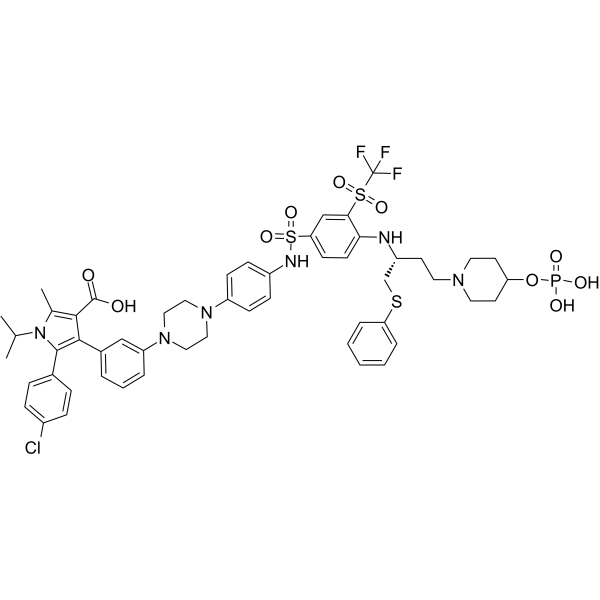
-
- HY-132126
-
|
|
SRPK
|
Others
|
|
SPHINX is a selective SRPK1 inhibitor with an IC50 value of 0.58 μM. SPHINX effectively reduces Choroidal Neovascularization (CNV) in vivo. SPHINX can be used for the research of (age-related macular degenaration) AMD .
|
-
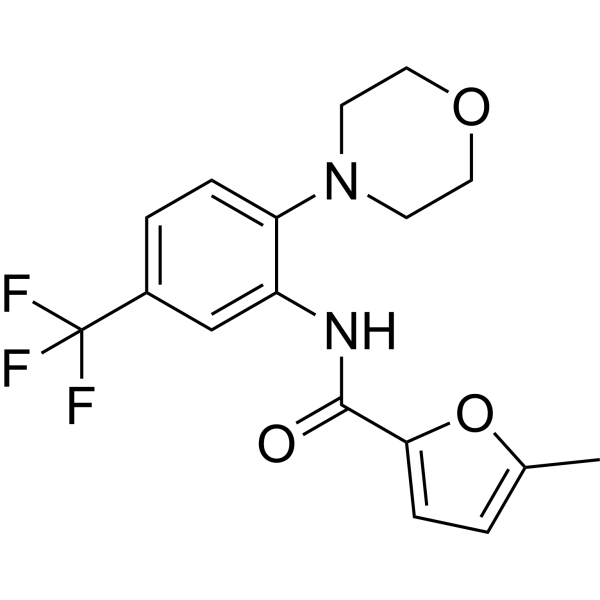
-
- HY-P9951
-
|
RG-6321
|
VEGFR
|
Cardiovascular Disease
|
|
Ranibizumab (RG-6321) is a humanized anti-VEGF monoclonal antibody fragment and can recognize all VEGF-A isoforms (VEGF110, VEGF121, and VEGF165) . Ranibizumab slows vision loss in vivo and is used for wet age-related macular degeneration (AMD) research .
|
-

-
- HY-P99298
-
|
RG 7417; TNX 234; Anti-CFD Recombinant Antibody
|
Complement System
|
Inflammation/Immunology
|
|
Lampalizumab (RG 7417) is a humanised monoclonal antibody targeting complement Factor D in the alternative complement pathway. Lampalizumab binds an exosite and sterically blocks Factor B access to the active site. Lampalizumab can be used for age-related macular degeneration (AMD) research .
|
-

-
- HY-P9951A
-
|
RG-6321 (anti-VEGF)
|
VEGFR
|
Cardiovascular Disease
|
|
Ranibizumab (RG-6321) (anti-VEGF) is a humanized anti-VEGF monoclonal antibody fragment and can recognize all VEGF-A isoforms (VEGF110, VEGF121, and VEGF165) . Ranibizumab (anti-VEGF) slows vision loss in vivo and is used for wet age-related macular degeneration (AMD) research .
|
-

-
- HY-N5118
-
|
(-)-Chimonanthine
|
Tyrosinase
|
Cancer
|
|
Chimonanthine is an alkaloid of Chimonanthus praecox, inhibits tyrosinase and tyrosine-related protein-1 mRNA expression, amd inhibits melanogenesis .
|
-
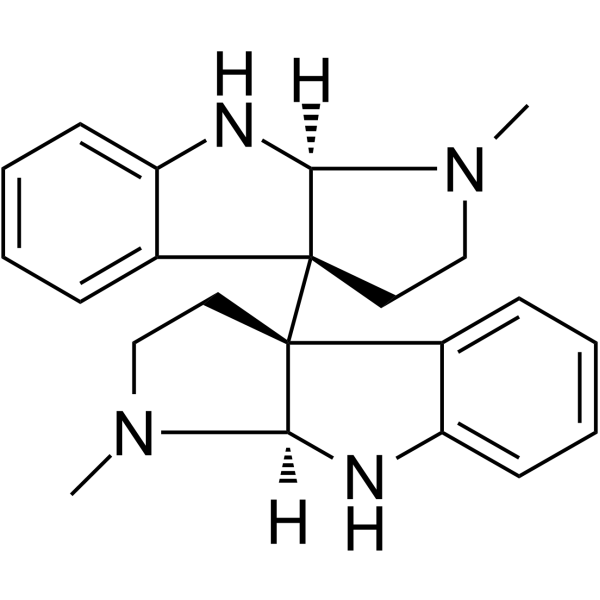
-
- HY-15492
-
|
AG-013958
|
VEGFR
|
Cardiovascular Disease
|
|
AG-13958 (AG-013958), a potent VEGFR tyrosine kinase inhibitor, is used for treatment of choroidal neovascularization associated with age-related macular degeneration (AMD) .
|
-

-
- HY-109561
-
|
EYE001; NX1838
|
VEGFR
|
Metabolic Disease
Inflammation/Immunology
|
|
Pegaptanib sodium is an RNA aptamer directed against vascular endothelial growth factor (VEGF)-165. Pegaptanib could be used for the study of neovascular age-related macular degeneration (AMD) .
|
-
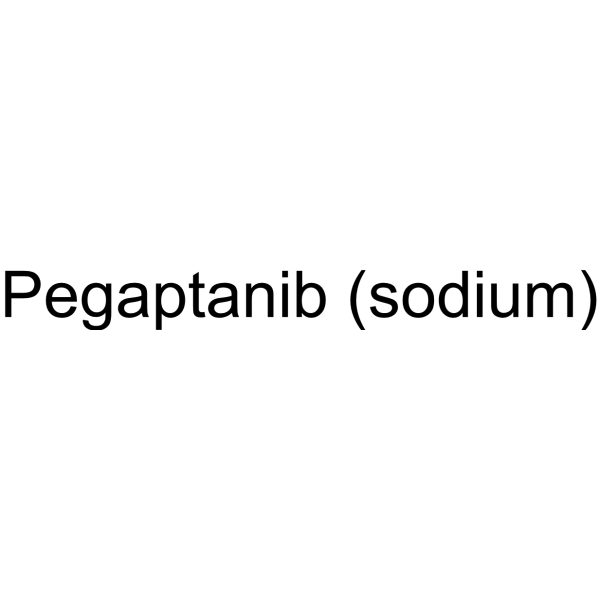
-
- HY-112256
-
ACP-105
5 Publications Verification
|
Androgen Receptor
|
Inflammation/Immunology
|
|
ACP-105 is an orally available, selective amd potent androgen receptor modulator (SARM), with pEC50s of 9.0 and 9.3 for AR wild type and T877A mutant, respectively.
|
-
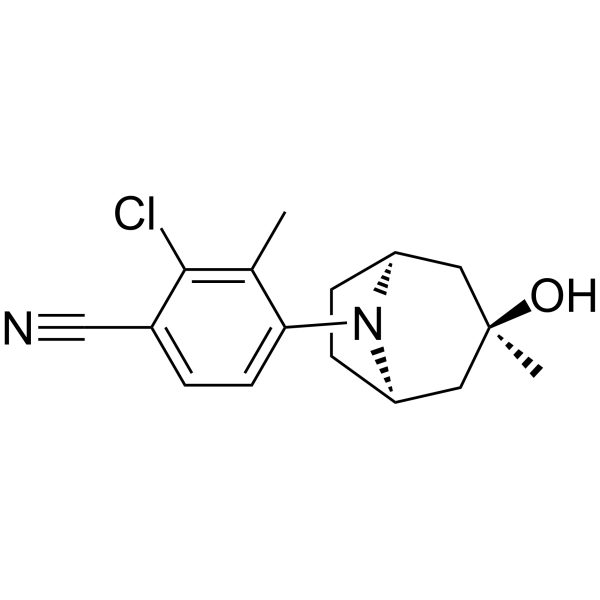
-
- HY-P99629
-
|
FHTR 2163; RG 6147; RO 7171009
|
Ser/Thr Protease
|
Neurological Disease
|
|
Galegenimab (FHTR 2163; RG 6147; RO 7171009), an anti-High-temperature requirement A1 (HTRA1) antibody fragment. Galegenimab can be used for age-related macular degeneration (AMD) research .
|
-

-
- HY-147080
-
|
ARC1905
|
Complement System
|
Others
|
|
Avacincaptad pegol (ARC1905) is an anti-C5 RNA aptamer that inhibits the cleavage of complement factor 5 (C5) into C5a and C5b. Avacincaptad pegol is being used for the study of age-related macular degeneration (AMD).
|
-

-
- HY-163403
-
|
|
VEGFR
|
Cardiovascular Disease
Cancer
|
|
VEGFR-2-IN-43 (compound 16) is an orally active inhibitor of VEGFR2, with an IC50 of 39.91 μM. VEGFR-2-IN-43 can be used for wet age-related macular degeneration (w-AMD) disease research .
|
-
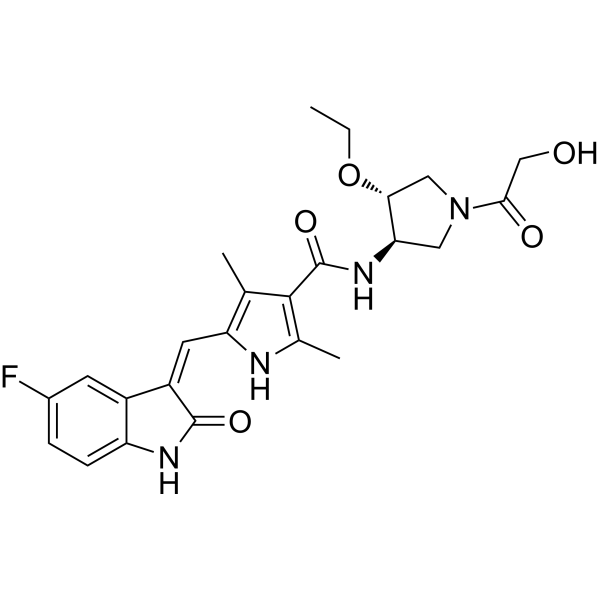
-
- HY-153484A
-
|
|
VEGFR
Small Interfering RNA (siRNA)
|
Others
|
|
Bevasiranib sodium is a siRNA designed to silence the genes that produce vascular endothelial growth factor (VEGF). It is widely accepted that vascular endothelial growth factor (VEGF) is a key component in the pathogenesis of choroidal neo-vascularization (CNV), which is a precursor to wet age-related macular degeneration (wet AMD).
|
-

-
- HY-153484
-
|
|
VEGFR
Small Interfering RNA (siRNA)
|
Others
|
|
Bevasiranib is a siRNA designed to silence the genes that produce vascular endothelial growth factor (VEGF). It is widely accepted that vascular endothelial growth factor (VEGF) is a key component in the pathogenesis of choroidal neo-vascularization (CNV), which is a precursor to wet age-related macular degeneration (wet AMD).
|
-

-
- HY-153183
-
|
|
Phospholipase
|
Cardiovascular Disease
Neurological Disease
|
|
Lp-PLA2-IN-12 (compound 19) is an Lp-PLA2 inhibitor. Lp-PLA2-IN-12 can be used for the study of neurodegenerative related diseases such as Alzheimer's disease (AD), glaucoma, age-related macular degeneration (AMD), or cardiovascular disease including atherosclerosis .
|
-
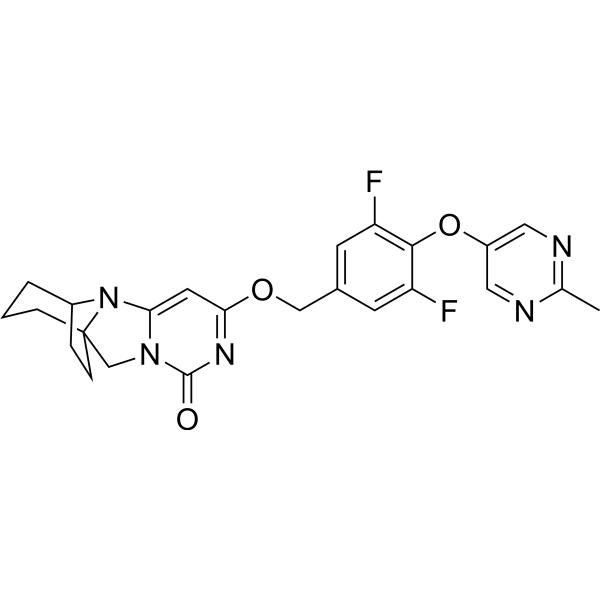
-
- HY-111793
-
|
|
CXCR
|
Neurological Disease
|
|
NUCC-390 is a novel and selective small-molecule CXCR4 receptor agonist. NUCC-390 induces internalization of CXCR4 receptors and acts in an opposite way of AMD3100 (HY-10046) . NUCC-390 promotes nerve recovery of function after neurodegeneration in vivo .
|
-
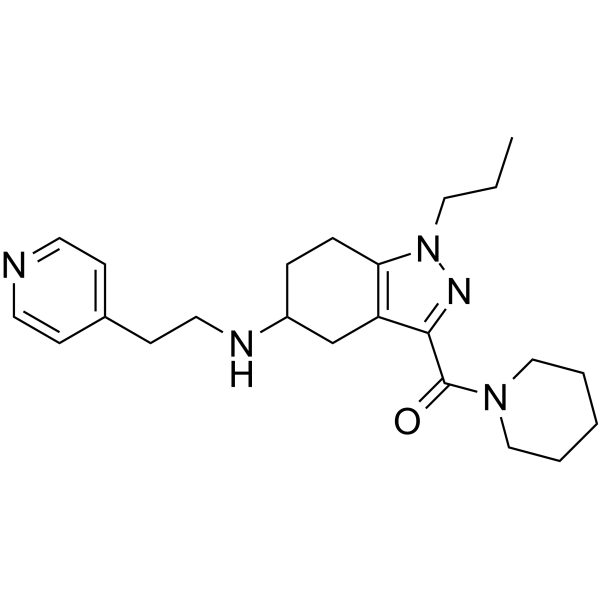
-
- HY-111793A
-
|
|
CXCR
|
Neurological Disease
|
|
NUCC-390 dihydrochloride is a novel and selective small-molecule CXCR4 receptor agonist. NUCC-390 dihydrochloride induces internalization of CXCR4 receptors and acts in an opposite way of AMD3100 (HY-10046) . NUCC-390 dihydrochloride promotes nerve recovery of function after neurodegeneration in vivo .
|
-
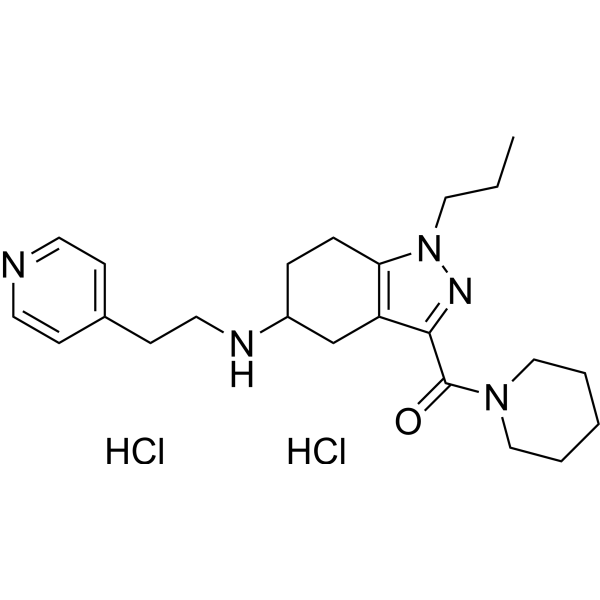
-
- HY-136788
-
|
AKST4290
|
CCR
|
Neurological Disease
Inflammation/Immunology
|
|
ALK4290 (AKST4290) is a potent and orally active CCR3 inhibitor extracted from patent US20130261153A1, compound Example 2, with a Ki of 3.2 nM for hCCR3 . ALK4290 can be used for the research of neovascular age-related macular degeneration and Parkinsonism .
|
-

-
- HY-10046S
-
|
|
Isotope-Labeled Compounds
CXCR
HIV
|
Infection
Inflammation/Immunology
Endocrinology
Cancer
|
|
Plerixafor-d4 is the deuterium labeled Plerixafor. Plerixafor (AMD 3100) is a selective CXCR4 antagonist with an IC50 of 44 nM. Plerixafor, an immunostimulant and a hematopoietic stem cell (HSC) mobilizer, is an allosteric agonist of CXCR7. Plerixafor inhibits HIV-1 and HIV-2 replication with an EC50 of 1-10 nM[1][2][3][4][7].
|
-

-
- HY-110117
-
|
|
Integrin
Interleukin Related
|
Inflammation/Immunology
|
|
BIRT 377 is a potent amd orally bioavailable inhibitor of the interaction between intercellular adhesion molecule-1 (ICAM-1) and lymphocyte function-associated antigen-1 (LFA-1), with a Ki of 25.8 nM. BIRT 377 also inhibits the production of IL-2 in vivo. BIRT 377 can be used for researching inflammatory and immune disorders .
|
-
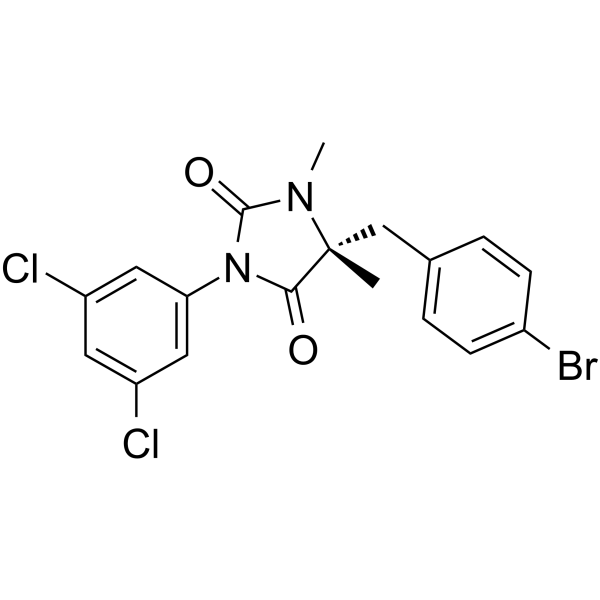
-
- HY-153560
-
|
|
Phospholipase
|
Neurological Disease
|
|
Lp-PLA2-IN-14 (Compound 19) is an Lp-PLA2 inhibitor with a pIC50 of 8.4 against rhLp-PLA2. Lp-PLA2-IN-14 can be used for the research of neurodegenerative related diseases, such as Alzheimer Disease (AD), glaucoma, age-related macular degeneration (AMD) or cardiovascular diseases including atherosclerosis and the like .
|
-
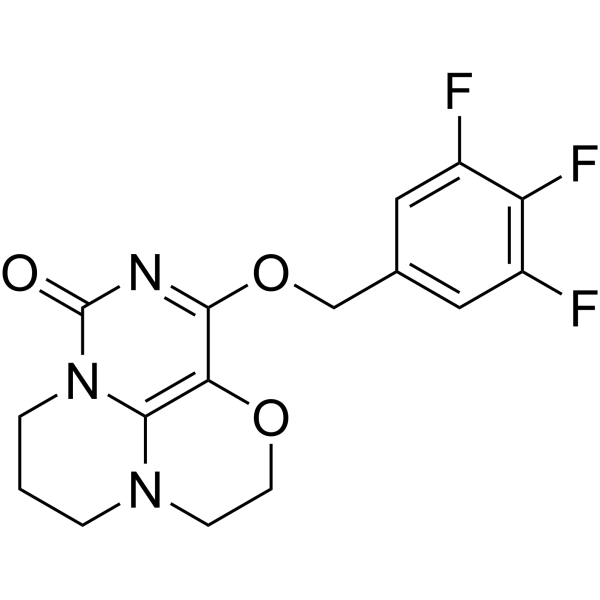
-
- HY-142778
-
|
|
Phospholipase
|
Neurological Disease
Metabolic Disease
|
|
Lp-PLA2-IN-10 is a potent inhibitor of lipoprotein-associated phospholipase A2 (Lp-PLA2). Lp-PLA2 previously known as platelet- activating factor acetylhydrolase (PAF-AH), is a phospholipase A2 enzyme involved in hydrolysis of lipoprotein lipids or phospholipids. Lp-PLA2-IN-10 has the potential for the research of neurodegenerative-related diseases such as Alzheimer's disease (AD), glaucoma, age-related macular degeneration (AMD), or cardiovascular diseases including atherosclerosis (extracted from patent WO2022001881A1, compound 4) .
|
-
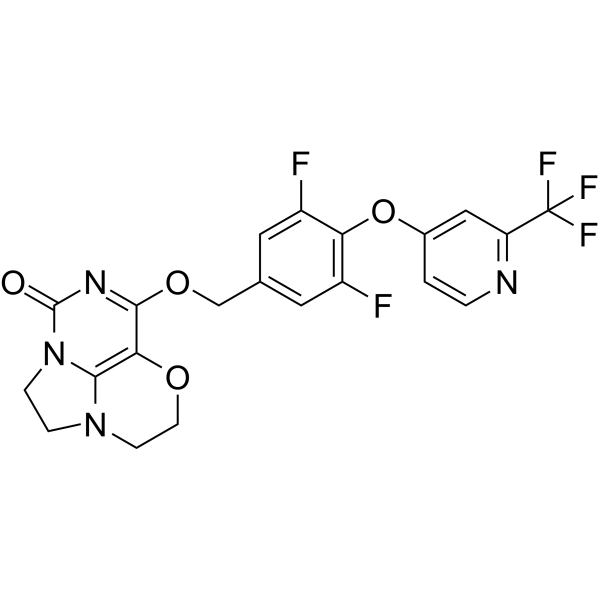
| Cat. No. |
Product Name |
Target |
Research Area |
-
- HY-16959
-
|
|
Peptides
|
Others
|
|
CEP dipeptide 1 is a CEP dipeptide with potent angiogenic activity; mediators of age-related macular degeneration (AMD).
|
| Cat. No. |
Product Name |
Target |
Research Area |
-
- HY-P99576
-
|
OG1953
|
VEGFR
|
Others
|
|
Tarcocimab (OG1953) is a humanized anti-VEGFA monoclonal antibody (IgG1 type). Tarcocimab is available for research in retinal vein occlusion (RVO) and wet age-related macular degeneration (AMD).
|
-
- HY-108801
-
|
VEGF Trap; VEGF-TRAPR1R2; VEGF-trapR1
|
VEGFR
|
Cardiovascular Disease
Metabolic Disease
|
|
Aflibercept (VEGF Trap) is a soluble decoy VEGFR constructed by fusing the Ig domains of VEGFR1 and VEGFR2 with the Fc region of human IgG1. Aflibercept inhibits VEGF signaling by reducing VEGF-regulated processes. Aflibercept can be used for thr research of age-related macular degeneration (AMD) and cardiovascular disease .
|
-
- HY-108801A
-
|
|
VEGFR
|
Cardiovascular Disease
Metabolic Disease
|
|
Aflibercept (VEGF Trap) is a soluble decoy VEGFR constructed by fusing the Ig domains of VEGFR1 and VEGFR2 with the Fc region of human IgG1. Aflibercept inhibits VEGF signaling by reducing VEGF-regulated processes. Aflibercept can be used for thr research of age-related macular degeneration (AMD) and cardiovascular disease .
|
-
- HY-P9951
-
|
RG-6321
|
VEGFR
|
Cardiovascular Disease
|
|
Ranibizumab (RG-6321) is a humanized anti-VEGF monoclonal antibody fragment and can recognize all VEGF-A isoforms (VEGF110, VEGF121, and VEGF165) . Ranibizumab slows vision loss in vivo and is used for wet age-related macular degeneration (AMD) research .
|
-
- HY-P99298
-
|
RG 7417; TNX 234; Anti-CFD Recombinant Antibody
|
Complement System
|
Inflammation/Immunology
|
|
Lampalizumab (RG 7417) is a humanised monoclonal antibody targeting complement Factor D in the alternative complement pathway. Lampalizumab binds an exosite and sterically blocks Factor B access to the active site. Lampalizumab can be used for age-related macular degeneration (AMD) research .
|
-
- HY-P9951A
-
|
RG-6321 (anti-VEGF)
|
VEGFR
|
Cardiovascular Disease
|
|
Ranibizumab (RG-6321) (anti-VEGF) is a humanized anti-VEGF monoclonal antibody fragment and can recognize all VEGF-A isoforms (VEGF110, VEGF121, and VEGF165) . Ranibizumab (anti-VEGF) slows vision loss in vivo and is used for wet age-related macular degeneration (AMD) research .
|
-
- HY-P99629
-
|
FHTR 2163; RG 6147; RO 7171009
|
Ser/Thr Protease
|
Neurological Disease
|
|
Galegenimab (FHTR 2163; RG 6147; RO 7171009), an anti-High-temperature requirement A1 (HTRA1) antibody fragment. Galegenimab can be used for age-related macular degeneration (AMD) research .
|
| Cat. No. |
Product Name |
Category |
Target |
Chemical Structure |
| Cat. No. |
Product Name |
Chemical Structure |
-
- HY-10046S
-
|
|
|
Plerixafor-d4 is the deuterium labeled Plerixafor. Plerixafor (AMD 3100) is a selective CXCR4 antagonist with an IC50 of 44 nM. Plerixafor, an immunostimulant and a hematopoietic stem cell (HSC) mobilizer, is an allosteric agonist of CXCR7. Plerixafor inhibits HIV-1 and HIV-2 replication with an EC50 of 1-10 nM[1][2][3][4][7].
|
-

Your information is safe with us. * Required Fields.
Inquiry Information
- Product Name:
- Cat. No.:
- Quantity:
- MCE Japan Authorized Agent:








































